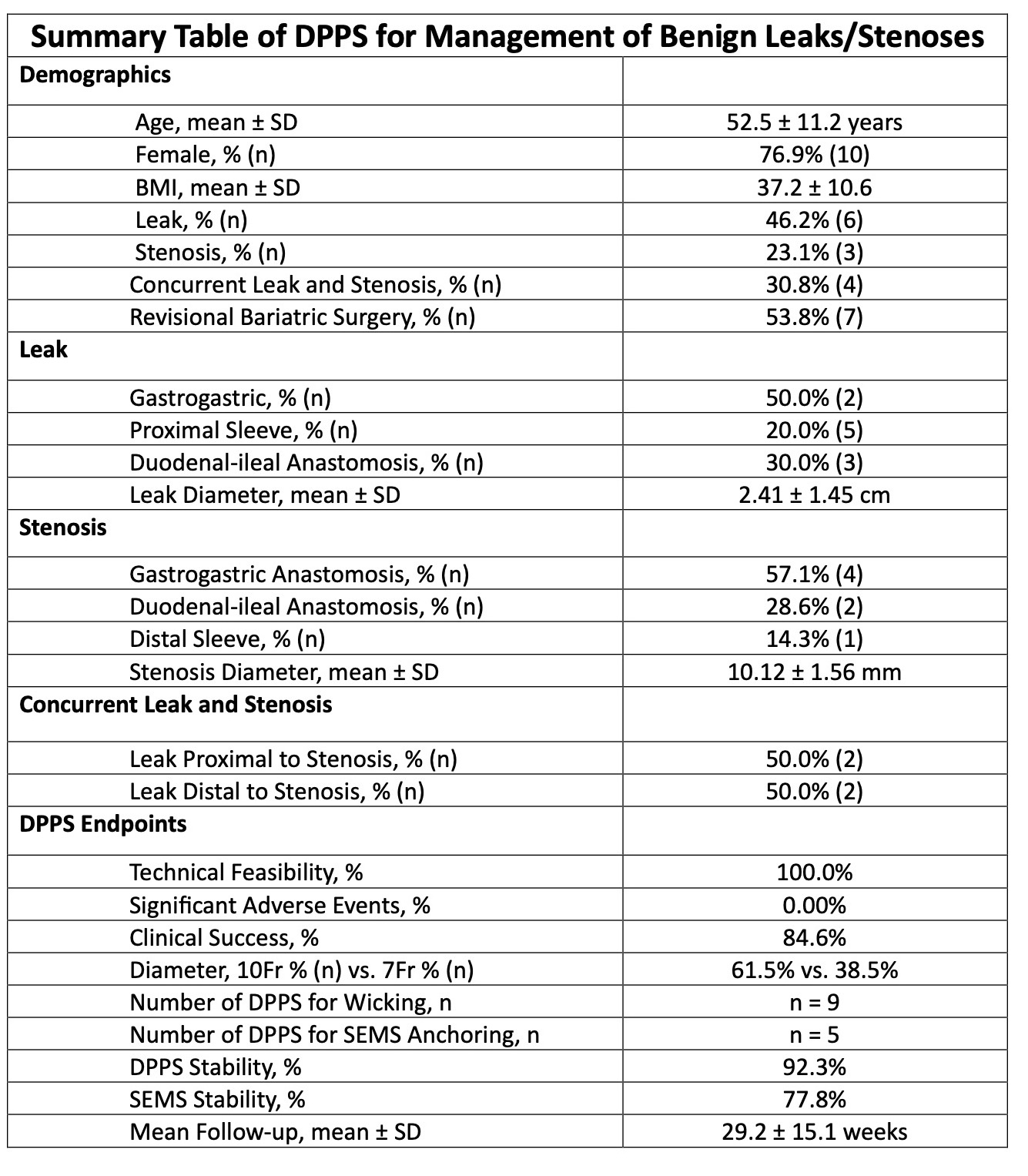Introduction:
Double pigtail plastic stents (DPPS) are effective in endoscopic treatment of post-operative leaks. Typically, they are placed transmurally (i.e. across the leak site) to facilitate internal drainage.
Additionally, DPPS can be placed intraluminally as an adjunct to conventional endoscopic treatment techniques, particularly for larger leaks, with or without associated stenoses. Intraluminal DPPS can splint open the true lumen and wick fluid “downstream” across leak sites and stenoses. Furthermore, intraluminal DPPS can anchor fully covered self-expanding metal stents (SEMS) which are otherwise prone to migration, particularly when used off-label for non-malignant gastric/small bowel targets.
We describe our experience with intraluminal DPPS as an adjunctive treatment for benign foregut post-surgical leaks and stenoses.
Methods:
Retrospective single-center study from 11/2021 to 10/2023 of 13 patients with benign foregut post-surgical anatomy who underwent endoscopic treatment involving placement of intraluminal DPPS. This was done either to (1) splint open the true lumen or (2) anchor fully-covered SEMS. Primary outcomes were technical success and safety. Secondary outcomes included: overall clinical success, migration rate of intraluminal DPPS and SEMS (Table 1).
Results:
Of the 13 patients, 77% were female, with mean age of 52.5±11.2 years. 54% (7/13) were revisional bariatric surgeries. The mean interval from surgery to endoscopic procedure was 26.5±17.1 days. The mean diameter of stenosis and leaks were 10.1±1.6 mm and 2.4± 1.4cm, respectively. Technical success of intraluminal DPPS placement was 100%. There were no serious adverse events related to intraluminal DPPS. Each patient was treated with a mean of 1.4±0.5 DPPS (Figure 1). Intraluminal DPPS stability was 92% (12/23), with migration occurring in 1 patient (passed naturally). When paired with DPPS, stability of covered metal stent was 78% (7/9). The mean dwell time for stenting was 42.1±29.2 days. 100% of patients underwent successful stent removal. Long-term clinical success was achieved in 85% of cases (11/13) over a mean follow-up time of 32±24.2 weeks.
Discussion:
Intraluminal double pigtail plastic stents (DPPS) can be a helpful adjunctive treatment for benign foregut post-surgical leaks and stenoses, particularly early in their course. While traditionally placed transmurally across leaks and fistulae, they can also be used intraluminally to (1) wick fluid across leaks and stenoses, and (2) to help anchor fully-covered self-expanding metal stents that are otherwise prone to migration. Our experience indicates high technical success and safety; high patient tolerability; low migration rates (either DPPS by themselves or paired with metal stents for anchoring); easy retrieval; and finally high rates of long-term clinical success.

Table 1: Summary of Study Results. This table provides an overview of the study results, encompassing demographic information, achieved outcomes, and endpoint analysis broken down by leaks and stenoses.

Figure 1: (a) Double pigtail plas.c stents (DPPS) placed coaxially to anchor fully covered self-expanding metal stent (SEMS) traversing proximal gastric sleeve leak. (b) Fluoroscopy of DPPS anchoring SEMS. (c) DPPS across early gastrogastric anastomosis stricture to promote downstream wicking of gastrointestinal fluid.